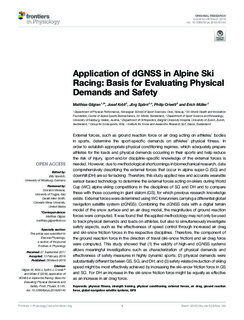| dc.contributor.author | Gilgien, Matthias | |
| dc.contributor.author | Kröll, Josef | |
| dc.contributor.author | Spörri, Jörg | |
| dc.contributor.author | Crivelli, Philip | |
| dc.contributor.author | Müller, Erich | |
| dc.date.accessioned | 2019-01-03T12:50:30Z | |
| dc.date.available | 2019-01-03T12:50:30Z | |
| dc.date.created | 2018-10-08T13:55:49Z | |
| dc.date.issued | 2018 | |
| dc.identifier.citation | Frontiers in Physiology. 2018, 9, 145. | nb_NO |
| dc.identifier.issn | 1664-042X | |
| dc.identifier.uri | http://hdl.handle.net/11250/2578983 | |
| dc.description.abstract | External forces, such as ground reaction force or air drag acting on athletes' bodies in sports, determine the sport-specific demands on athletes' physical fitness. In order to establish appropriate physical conditioning regimes, which adequately prepare athletes for the loads and physical demands occurring in their sports and help reduce the risk of injury, sport-and/or discipline-specific knowledge of the external forces is needed. However, due to methodological shortcomings in biomechanical research, data comprehensively describing the external forces that occur in alpine super-G (SG) and downhill (DH) are so far lacking. Therefore, this study applied new and accurate wearable sensor-based technology to determine the external forces acting on skiers during World Cup (WC) alpine skiing competitions in the disciplines of SG and DH and to compare these with those occurring in giant slalom (GS), for which previous research knowledge exists. External forces were determined using WC forerunners carrying a differential global navigation satellite system (dGNSS). Combining the dGNSS data with a digital terrain model of the snow surface and an air drag model, the magnitudes of ground reaction forces were computed. It was found that the applied methodology may not only be used to track physical demands and loads on athletes, but also to simultaneously investigate safety aspects, such as the effectiveness of speed control through increased air drag and ski–snow friction forces in the respective disciplines. Therefore, the component of the ground reaction force in the direction of travel (ski–snow friction) and air drag force were computed. This study showed that (1) the validity of high-end dGNSS systems allows meaningful investigations such as characterization of physical demands and effectiveness of safety measures in highly dynamic sports; (2) physical demands were substantially different between GS, SG, and DH; and (3) safety-related reduction of skiing speed might be most effectively achieved by increasing the ski–snow friction force in GS and SG. For DH an increase in the ski–snow friction force might be equally as effective as an increase in air drag force. | nb_NO |
| dc.language.iso | eng | nb_NO |
| dc.subject | GPS | |
| dc.subject | air drag | |
| dc.subject | external forces | |
| dc.subject | global navigation satellite systems | |
| dc.subject | ground reaction force | |
| dc.subject | physical conditioning | |
| dc.subject | physical fitness | |
| dc.subject | strength training | |
| dc.title | Application of dGNSS in alpine ski racing: Basis for evaluating physical demands and safety | nb_NO |
| dc.type | Journal article | nb_NO |
| dc.type | Peer reviewed | nb_NO |
| dc.description.version | publishedVersion | nb_NO |
| dc.rights.holder | © 2018 Gilgien, Kröll, Spörri, Crivelli and Müller. This is an open-access article distributed under the terms of the Creative Commons Attribution License (CC BY). The use, distribution or reproduction in other forums is permitted, provided the original author(s) and the copyright owner are credited and that the original publication in this journal is cited, in accordan | nb_NO |
| dc.source.pagenumber | 11 | nb_NO |
| dc.source.volume | 9 | nb_NO |
| dc.source.journal | Frontiers in Physiology | nb_NO |
| dc.identifier.doi | 10.3389/fphys.2018.00145 | |
| dc.identifier.cristin | 1618728 | |
| dc.description.localcode | Seksjon for fysisk prestasjonsevne / Department of Physical Performance | nb_NO |
| cristin.unitcode | 150,31,0,0 | |
| cristin.unitname | Seksjon for fysisk prestasjonsevne | |
| cristin.ispublished | true | |
| cristin.fulltext | original | |
| cristin.qualitycode | 1 | |
